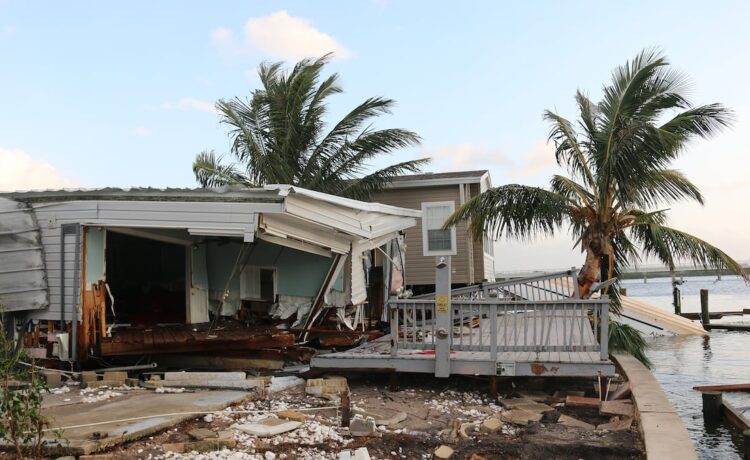Tampa Bay leaders say federal hurricane relief funds hang in the balance after the New York Times reported Thursday that the Trump administration has planned sweeping layoffs to an office overseeing recovery from the largest U.S. disasters.
The administration took aim at the Office of Community Planning and Development, part of the Department of Housing and Urban Development, also known as HUD, and proposed to slash the office’s workforce by 84%, from 936 employees to 150, according to a document obtained by The New York Times.
Tampa Bay cities and counties hit hardest by hurricanes Helene and Milton last year are slated to receive $2.2 billion in relief money meant to repair affordable housing and public infrastructure damaged by the storms.
Community Development Block Grant Disaster Recovery funds can be used for a wide range of recovery and mitigation projects, but aim to “help communities and neighborhoods that otherwise might not recover due to limited resources,” according to the department’s website.
The grant is the only federal disaster recovery assistance that primarily benefits low- and moderate-income households.
The funding “supports disaster relief, long-term recovery, restoration of infrastructure and housing, economic revitalization and mitigation in the most impacted and distressed areas,” according to a since-deleted news release announcing the Florida funds in January and obtained through the WayBack Machine, a digital archive.
“Disaster recovery efforts are a top priority and will not be impacted,” said Kasey Lovett, spokesperson for the federal agency, in a statement to the New York Times. “HUD’s mission to serve all communities — especially following tragedies — remains unchanged.”
Kathleen Peters, chairperson of the Pinellas County Commission, said she worries more than $800 million allocated to the county could be in jeopardy if there are dramatic cuts to the office’s workforce.
“It’s a very quick timeline that we have to meet, and then we’re just worried about if there’ll be enough staffing to approve that — to execute it — to ensure that we still get the money,” she said.
Peters said Pinellas planned to use the federal funds to replace traffic lights damaged by back-to-back storms and make crucial upgrades to sewage and stormwater systems, many of which failed and caused raw sewage to overflow into communities and waterways.
The funds could also be provided as loans and grants to business owners struggling to recover from the hurricanes.
“We really want to get those resources in the hands of the citizens,” Peters said. “We just want to be able to do it quickly. And we’re hoping that with those cuts, somehow that won’t be impacted, but I’m sure it will be.”
Keep up with Tampa Bay’s top headlines
Subscribe to our free DayStarter newsletter
We’ll deliver the latest news and information you need to know every morning.
You’re all signed up!
Want more of our free, weekly newsletters in your inbox? Let’s get started.
Peters said the mass layoff could also threaten the county’s progress toward building more affordable housing.
In Hillsborough County, it’s also unclear what the cuts would mean for programs that rely on these federal funds.
In 2023, the federal housing agency’s funds made up at least 72% of the Tampa Housing Authority’s budget. The public housing agency, which provides housing assistance to more than 15,000 families in in the region, dispersed $143 million in housing assistance payments from those federal funds last year.
The housing agency, which does not provide emergency housing related to disasters, relies on federal funds separate from the disaster grants dispersed by the office threatened by layoffs. But some tenants who rely on its services were displaced by last year’s hurricanes.
About a dozen affordable housing units managed by the housing authority were damaged by Helene and Milton, said Rose Lugo, a spokesperson with the agency.
The housing authority relied on funding from the federal housing agency and other sources to rebuild those homes, Lugo said.
“Our hope right now is that the plans of this administration helps us sustain the level of services to the families that we service here in the Tampa area,” she said.
A spokesperson for Hillsborough County was working Thursday to confirm whether the county had received any of the $700 million it is expected to receive from the federal agency for disaster relief.
Peters said she doesn’t know what the proposed federal layoffs might mean for future disaster funding in the region.
Trump’s recent moves remind her of shake-ups spearheaded by former Florida Gov. Rick Scott during his tenure, she said. In 2011, Scott dissolved the growth management agency that oversaw local planning across the state.
“A lot of what the president is doing at the national level, (Scott) did at the state level. There was a lot of fear, and, in the end, a lot of it all worked out,” Peters said. “I‘m going to be optimistic and figure that however they restructure, it’s going to work out. It’s just going to be a new way of doing things.”
***
Here is a breakdown of how much the state and some local governments are set to receive from the Department of Housing and Urban Development:
Florida: $925,394,000
Hillsborough County: $709,324,000
Pasco County: $585,704,000
Pinellas County: $813,783,000
St Petersburg: $159,884,000
Manatee County: $252,711,000
Sarasota County: $210,094,000
Orange County: $33,357,000
Lee County: $100,683,000
Volusia County: $133,515,000
Broward County: $29,222,000
Fort Lauderdale: $88,051,000
Times staff writer Michaela Mulligan contributed to this report.
















